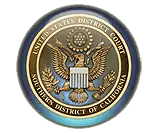Playboy Enterprises, Inc. v. Welles
Playboy Enterprises, Inc. v. Welles was a United States district court case between former 1981 Playboy Playmate of the Year ("PMOY") Terri Welles and Playboy Enterprises, Inc. in which Welles was accused of trademark infringement and trademark dilution in her use of Playboy's trademarked terms in the metatags of her website.
| Playboy Enterprises Inc. v. Terri Welles Inc. | |
|---|---|
 | |
| Court | United States District Court for the Southern District of California |
| Full case name | 'Playboy Enterprises Inc., v. Terri Welles Inc., Terri Welles, Steven Huntington, Michael Mihalko, and PIPPI, Inc. |
| Decided | December 1, 1999 |
| Docket nos. | 98-cv-0413 |
| Holding | |
| Welles' nominative use of Playboy's trademarked terms in the metatags of her web site was fair use because web users must utilize identifying words to find their intended web site. Not all web searches utilizing the words "Playboy," "Playmate," and "Playboy Playmate of the Year 1981" are intended to find "Playboy" goods or the official "Playboy" site. There was no likelihood of confusion between Defendant's website and Playboy's trademark. Defendant's fame and recognition derive from her popularity as a Playboy model and Playmate of the year, thus her use of the trademarked terms was descriptive (nominative). | |
| Court membership | |
| Judge(s) sitting | Judith N. Keep |
| Keywords | |
| trademark infringement, trademark dilution, metatags, cyberlaw | |
Facts
Welles maintained a website which identified her as a former PMOY and displayed the registered trademarked terms Playboy, Playmate of the Year, and Playmate of the Month and the unregistered trademark "PMOY" in metatags, wallpaper, banner ads, and the masthead. Playboy sued Welles, claiming both trademark infringement and trademark dilution.
Defendant was featured on the cover of a 1981 Playboy magazine. Defendant was a Playboy model and Playmate of the Year who used these trademarked terms to describe herself via her personal website. Plaintiff's sued Defendant for Defendant's under two theories: trademark infringement and trademark dilution.
Opinion of the Court
The Court held that nominative use (a type of fair use for discussing the product itself) is permitted where:
- The product or service can not be readily identified without using the trademark (i.e. trademark is descriptive of a person, place, or product attribute);
- Only so much of the mark may be used as is reasonably necessary for identification (e.g. the words may be reasonably used but not the specific font or logo); and
- The user does nothing to suggest sponsorship or endorsement by the trademark holder - which applies even if the nominative use is commercial.
Here, the Ninth Circuit Court applied the nominative fair use test to the defendant and concluded the Defendant's use of these trademarked items was permissible because there was no other practical way for the Defendant to describe herself. The Plaintiff was relying on the decision in Brookfield Communications, Inc. v. West Coast Entertainment Corp., to support the contention that the Defendant's use of Playboy trademark in her web site infringes on its trademark by causing likelihood of confusion shown on the basis of initial interest confusion.
However, the court added that the Plaintiff's reliance on Brookfield was misplaced. None of the cases which Brookfield discusses involved fair use defense or a use of trademarks in the metatags which accurately and fairly described the contents of the web page or web site.
The court defined Plaintiff's use of the theory of 'initial interest of confusion' as "confusion of 'consumer attention, even though no actual sale is finally completed as a result of the confusion." In order for this type confusion to be actionable under the Lanham Act, several factors must be reviewed:
- Evidence of the initial interest confusion as being "damaging and wrongful,"
- Evidence that confusion between two products "will mistakenly lead the consumer to believe there is some connection between the two and therefore develop an interest in the defendant's line that it would otherwise not have," or
- Evidence that the "situation offers an opportunity for sale not otherwise available by enabling defendant to interest prospective customers by confusion with the plaintiff's product."
In this case, the Plaintiff failed to present any of the facts indicating:
- Any initial interest confusion was "damaging and wrongful;"
- Anyone believes or is likely to believe there is a connection Welles' site and Playboy's.
- Welles received "opportunities for sale not otherwise available" by confusing web users; or
- Any of Welles' actual customers were in the "appreciable number," or majority of people who when plugging in one of the Plaintiff's trademark terms into a web browser search engine, was "looking for Playboy's official site."
There was also no evidence Welles intended to divert Plaintiff's customers to her web site by trading on Playboy's goodwill. This intent was relevant since the court in Brookfield stated that in "Dr. Seuss, the Ninth Circuit explicitly recognized that the use of another's trademark in a manner calculated to capture initial consumer attention, even though no actual sale is finally completed as a result of the confusion, may be still an infringement." Brookfield at 1062.
Conclusion
The court wanted to render an analysis that was flexible and reflective of "emerging technologies", but also wanted to uphold common sense principles of trademark law.
On appeal, the Ninth Circuit affirmed the district court's conclusion with respect to Welles' use of metatags because the court considered the use nominative.